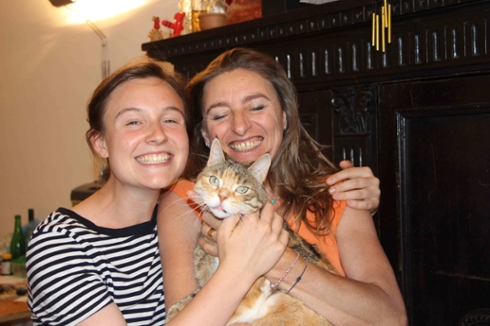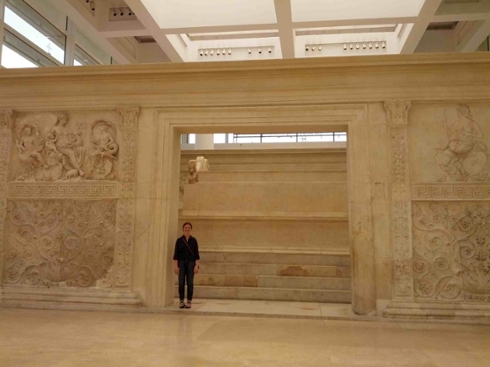Tags
"classics"
Presidents Summer Fellowship 2015: Haley Tilt, Visual Memory and Livy, Part 3
Haley Tilt, '16, Classics, is adventuring in Rome, tracing and chronicling the geography described by the ancient historian Livy. She plans to create a virtual, interactive map of ancient Rome, based on Livy's depictions.
The last couple of months have seen me ceaselessly behind my computer, tapping away at my keyboard (and more often, my delete key). Working in combination with the SDS was decidedly a good idea. It gave me access to support I couldn't have done without and a group of other folks equally confused as I. Working in combination with others held me accountable for explaining my ideas, for slowing down and dedicating time to decision making, and it allowed me to bounce a quick--or significant--question off someone else. Strangest thing of all, after two months, I am able to answer other peoples’ questions.
And I am able to build a website. It hasn’t been released yet, and probably won’t be until it’s endured a bit more tinkering, but Livy doesn’t come up on the Hum 110 syllabus until Spring, and I have a few more features I want to add. Things moved more slowly than I anticipated, and I learned that web development is actually rather difficult, a good deal more difficult than I anticipated. Just to give an idea of the breadth of concepts I had to explore: there was SQLITE, the language I used to talk to the database containing all of my images, notes, textual selections, etc., there was python coding, to build the web server, there was HTML/CSS, to build individual web pages and style them, and there were javascript and jquery, to handle all of the ‘interactive’ elements of the site. Although I had some experience with python and javascript, everything else was completely new to me, and connecting all of the pieces, passing packets of information between components and learning to unpack those packets at their final destination, was hard. Some of the features whose implementation I thought would be trivial were actually beyond the scope of my current skill-set, so in addition to learning how to develop my project, I also had to learn to think in stages. This particular instantiation of the project will allow people to view a map side-by-side with the selection of Livy’s text that is relevant to the location they have clicked, and to view images of that location today. As I move forward with the project, I want users to be able to do side-by-side comparisons between modern images of sites and reconstructions of those sites, and I want to bolster the research I’ve already done to better document how each of the sites Livy discusses have come to look the way they do today.
Presidents Summer Fellowship 2015: Haley Tilt, Visual Memory and Livy, Part 2

Haley Tilt, '16, Classics, is adventuring in Rome, tracing and chronicling the geography described by the ancient historian Livy. She plans to create a virtual, interactive map of ancient Rome, based on Livy's depictions.
My last weeks in Rome were glorious. Finally comfortable with the city, I decided it was time to venture out into the other, more remote places Livy discusses. One of these places was the town of Veio, forty minutes North of Rome by car, two or more hours by bus.
On the rolling hills above Veio sleep the remains of Veii, the jewel of ancient Etruscan cities. Now a national park, Veii offers little to a casual tourist group. Once immense, the only area of the city now accessible to visitors is a reconstruction of a temple complex dedicated to Apollo. It’s beautiful, but not what I’m looking for. I’m searching for the cittadella, the citadel of Veii, and the seat of the symbolic power Veii held for Livy. The maps I’m accustomed to in US parks never manifest, so I’m left asking the few locals walking their dogs if they know what I’m looking for. No, they tell me, they don’t know where the cittadella is. Finally I find a woman sitting beside a waterfall, and when I ask her my question, she responds to me in perfect English, peppered with a funny combination of Italian and British sounds. Yes, she knows where it is, and she gives me detailed directions, which I will later botch completely, wandering through the hidden parts of the park. She even knows a version of Veii’s defeat by Rome, decidedly different from the version in Livy.
Presidents Summer Fellowship 2015: Haley Tilt, Visual Memory and Livy

Right now I’m sitting at the kitchen table in a warm and eclectic apartment in Rome. The last two weeks have been a whirlwind of travel, stilted but enthusiastic conversations, and incredible museums. Most of all, my two weeks in Rome have seen me dogging the footsteps of one of the most influential and prolific historians of the ancient world. My project is founded on the idea that Livy is doing something special with space in his histories, setting stories in places that are highly specific and would have been familiar to his contemporaries. Like the ancient rhetorical technique of the memory palace, Livy capitalizes on the visual memory of his readers. Also like the memory palace, Livy’s stories imprint themselves on the spaces they occupy. After reading a particularly grisly passage, in which Tullia drives her chariot over her father’s corpse, the location of which, Livy informs us, is “as far as the top of the Cyprius Vicus, where the temple of Diana lately stood… to the right on the Urbius Clivus, to get to the Esquiline,” a reader will thereafter recall that spot as the scene at which his anecdote took place. My goal has been to hunt these places down, to photograph them, and to plot them on a digital, interactive map, so that modern readers might better understand this aspect of Livy’s text.
What I’ve found is a city that has been profoundly altered. Of course I knew that this would be the case; many of the monuments Livy discusses are now fragmentary and some are gone entirely. Many once-open spaces are now densely packed with buildings.
I knew that this would be the case, and I even welcomed the opportunity to engage with the modern city the same way Livy did--by countering absence with remembrance. In the example above, Livy recalls that the temple of Diana “lately” was standing. Present in his readers’ memories, but absent from their physical world, the temple (and so many other spaces altered by the Augustan building program), have become another level of Rome’s historical and topographical memory.
Interview with William Vickery
Madeline Wagar ’16, Assistant Editor with Works & Days, interviewed William Vickery '10, Classics major and Senior Investigator at Mintz Group.
Tell me a bit about Mintz Group.
I’ve been working with Mintz since January of 2012. Mintz is a traditional private investigation firm specializing in corporate intelligence gathering. Clients contact us when they are interested in figuring out what their competitors are doing. Clients are often interested in looking into how other people in their field are using similar trademarks, or in figuring out who is the best to do business with in their field of interest. It’s a very diverse company. Our operations fall into three categories. The first is foreign relationships, so we are investigating corporations around the world and making sure they are reputable. The second category is disputes and litigations. This category contains a lot of white-collar work. It’s often employment related, or dealing with the Internet, tasks like website preservation. We try to discover what has worked successfully in the past. We also investigate employee misconduct, so we might come in after an employee makes off with $100,000 to figure out how they did it. We will put together a profile of how it was accomplished, and the client can work out a plan for prevention in the future.
Continue reading Interview with William Vickery
